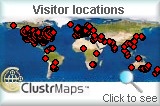I’m sure by now you’ve heard about the Anti-Clinton “viral-video” (here’s another link about it).What a great video to use to discuss the importance of Digital Literacy in the 21st Century. Hopefully it’s being used in many schools to spark debates and examination of the important skills needed these days to evaluate the plethora of information.
One thing that was interesting to me was how I learned about the video. Brian Williams from “NBC Nightly News” brought it to my attention on my way to work yesterday, while driving in the car. I often drive to work with Mr. Williams, via audio podcast of the previous evening’s news. Usually, the audio is sufficient to enjoy the program, but in this case, I really wished I had the video. Williams described that the video was “meant to mimic” the “1984 Apple Ad“. To me, mimic means a “remake”. As I heard the audio, in my mind I tried to imagine what the film looked like, and how close the creator was able to capture the feel of the original ad. Williams goes on to say that the ad “has a lot of people wondering just who has gone to such great lengths (my italics)” and that on “this one, somebody spent some money on it.”
So, I was shocked to see the video today and find out that it is in fact not a remake, but the original ad which has been doctored.
Not only is the ad misleading (i.e., does not in fact come from the Obama camp), but the media reporting on it (NBC) is misleading, or at least, misinformed. When Williams says that someone with “some money” put this out and that they went to great lengths, that implies that there is substantial power or clout behind this attack. In fact, his guest that he has relates it to the Swift Boat attacks on Kerry, but says it is more harmful because we don’t know who made it, where it’s coming from.
What has to also take place in the discussions of how to evaluate information in this digital age, is an understanding of how content (how easily!) is created. It baffles me that NBC (television/media producers afterall) mistook this ad as “big money” and “time intensive”. Knowing the little that I know about Final Cut (video editing software), this project was probably done in about a half an hour, on somebody’s home computer.
In evaluating truth or lies of information, students need to see “behind the curtain” and understand the process that went into making that information. Students must learn how to see beyond the flash and glitter of the message and get to its core in order to evaluate it.
I’m not sure if Williams or the NBC team has ever seen the original 1984 Apple video. If they have, I’m not sure why they didn’t explain that only the “Big Brother” face has changed to that of Ms. Clinton’s. Think of that student in your class who has never seen the original and also believes that this video was made from scratch, from the ground up. They would be impressed, possibly as much as we were back in 1984 when the original aired. Even by today’s standards, it’s a great ad.
And also think of another student: possibly the one in the back of your high school classroom. The one who is savvy enough to get his hands on a copy of Final Cut Pro, and is the actual creator of this video. This will help remind us that we need to not only be teaching about information evaluation, but also about information creation and all its ethical implications.






5 responses so far ↓
1 Lori Burch // Mar 29, 2007 at 5:34 pm
I’ve been thinking a lot about this lately and I definitely agree that we, as educators, have a responsibility to talk to students about validating information and about ethical, responsible use of information. We can’t afford not to and neither can our students. I’ve also been thinking about the “democratization” of information and the impact that has on us. In the past, we had many fewer sources of information on political topics as well as on other things. We had newspaper, TV, political ads and political gatherings of one sort or another, but so much of that WAS controlled by corporations, by candidates, by people with the money and the power to produce the information and disseminate it. Now, anyone, including that quiet student in the back of the room, can “make media” and publish it to the world. That adds so many more voices to the political fray, voices of the people. Kind of puts me in mind of the origins of our country when the voices of the common people seemed to have more impact. I think of myself as a product of lots of pieces, of many experiences that all contribute to the thoughts, ideas, and perceptions that I eventually come to call my own. I’m rather thrilled to think that there are so many more possible points of view to intrigue me and to contribute to what I think about and how I view the world. However, as you point out, Bob, I can’t be a passive vessel for “knowledge” to pour into. I must be an active participant and I must think about things, evaluate the information I’m encountering, prioritize and analyze. I need to be a much higher level thinker, a more vigilant, analytical consumer of information. I really need to interact with and spend some time processing information, rather than just taking it at face value. I find that exciting on a personal level, but also challenging in terms of the implications it has on education and instruction.
2 Justin // Mar 29, 2007 at 10:13 pm
This blog caught my eye and I found it very interesting in that I am one of those individuals who has never seen the original Apple ad. Because I have grown up with rise of the internet into what it is today, I feel I have been educated enough to look at all online material with a critical eye. Yet, this ad still shows that because I didn’t know the background behind the original ad, I had a very different perception than someone who did understand its history. I agree that it is very important as we move towards a more interactive internet, where anyone and everyone can be an author, to educate our students on how to be critical of what they encounter.
Research skills have greatly changed from the days of going to the library. We need to understand that along with teaching research skills on the internet we need to make sure students understand the differences between credible and non-credible sources.
3 Ecommerce Tips and Resources // Aug 19, 2007 at 3:23 am
Ecommerce Tips and Resources…
I couldn’t understand some parts of this article, but it sounds interesting…
4 Business Career Center // Sep 7, 2007 at 4:58 pm
Business Career Center…
I couldn’t understand some parts of this article, but it sounds interesting…
5 glamour-agency // Sep 29, 2007 at 1:41 am
Digital Studio Modeling…
hey great stuff…
Leave a Comment